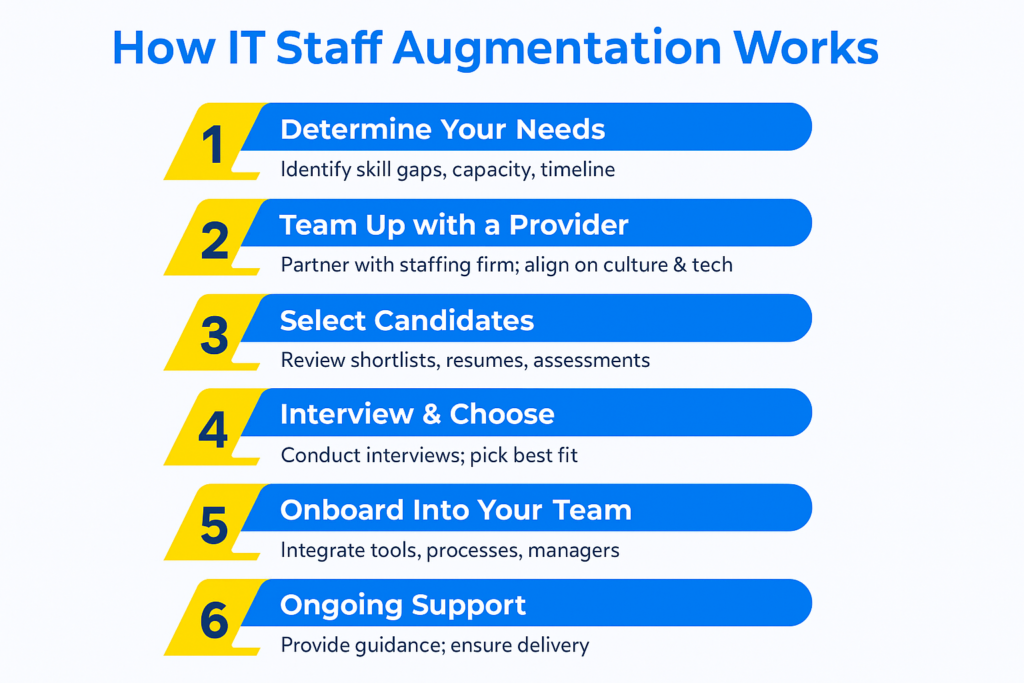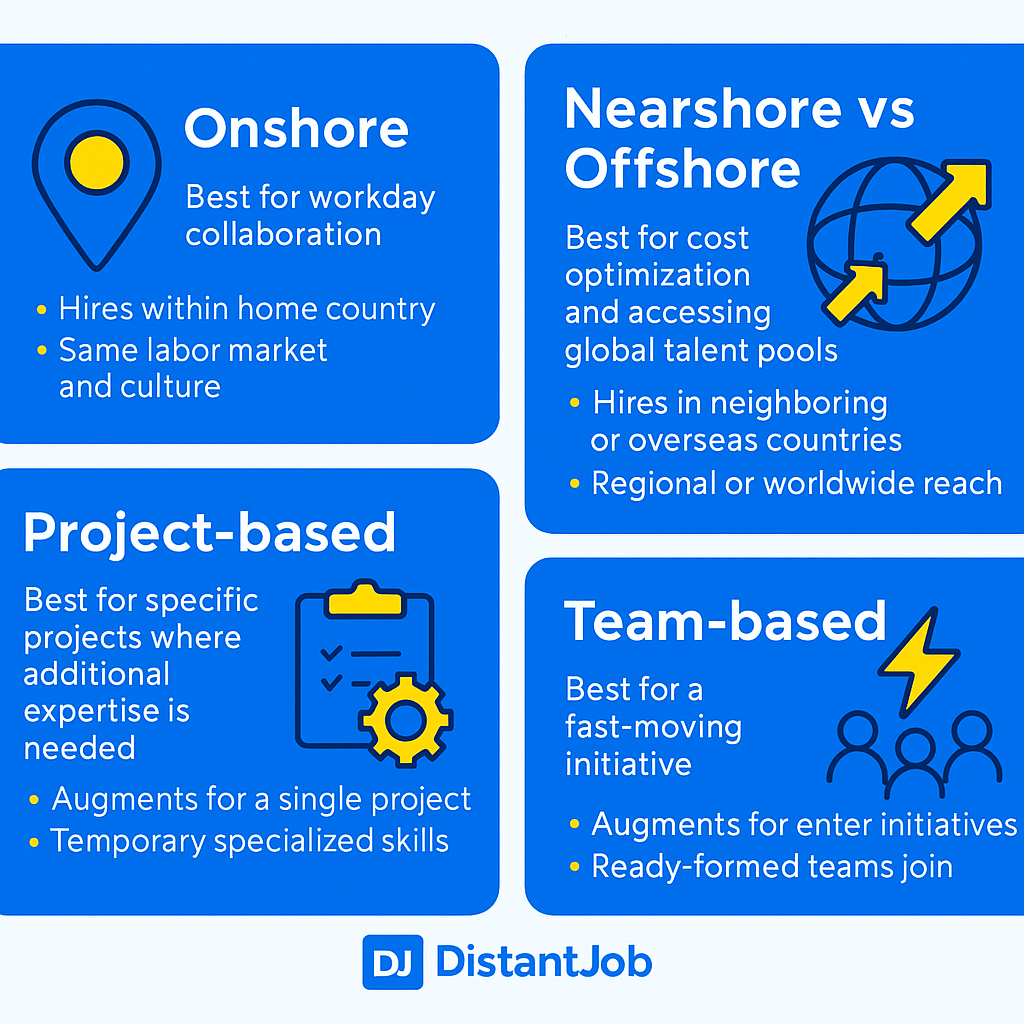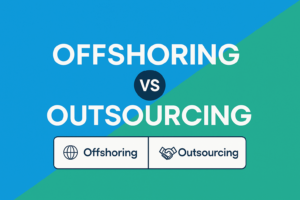IT staff augmentation can boost operational efficiency. This is especially true for small businesses and startups that don’t always have the IT skills they need in-house for specialized projects. Plus, hiring full-time staff for temporary or specialized work can be expensive and just not practical.
According to McKinsey, half of business owners report having trouble filling IT positions, and roughly 90 percent report finding no qualified candidates at all.
One solution businesses are turning to is staff augmentation, which allows organizations to quickly scale their IT teams up or down as needed. It doesn’t involve long-term commitments or the overhead costs associated with permanent hires. No wonder it is increasingly popular. The IT staff augmentation market has soared, valued at $299 billion in 2023 and projected to reach $1,072 billion by 2032, according to a Business Research Insights report.
So, the question is, where does this hiring model fit into your organization’s IT strategy?
The answer is in this detailed guide below. We cover everything you need to know about IT staff augmentation, including its challenges and choosing a provider. That way, you can decide if it is right for you. But first, let’s define staff augmentation.
What Is IT Staff Augmentation?
IT staff augmentation is a hiring strategy that lets you quickly add pre-vetted, skilled tech professionals to your existing team without the cost and time of traditional hiring. Unlike outsourcing, where you hand off entire projects, you maintain full control, and augmented developers work as an extension of your in-house team, following your processes and reporting directly to your managers.
For example, one of our clients faced challenges in adapting to rapidly evolving regulatory standards. They needed proficient Cloud engineers to swiftly grasp the intricacies of compliance and motivate their dev team.
Through a few months of staff augmentation, they successfully onboarded skilled professionals, enabling a seamless transition of their assets and ensuring compliance with all regulatory mandates.
| Key Features | Description |
| Integration | The professionals work directly with your team and your management. They are temporary members of your workforce. |
| Control | Your company keeps total control and accountability over the tasks, methodologies, processes, and daily priorities. |
| Focus | Filling a gap on your team (e.g., a full-stack developer, a cloud expert) to increase the team’s capacity. |
| Resources | They use your tools and work on your environment. These workers follow your policies and culture. |
How IT Staff Augmentation Works
IT staff augmentation starts with understanding your needs and partnering with a competent staffing provider. This vendor then sources and vets qualified candidates matching your technical specifications, culture, and project goals.
The following steps are how a company can implement IT staff augmentation:

1. Determine Your Needs
Start by identifying the gaps in your current team’s capabilities or extra resources needed to complete new or ongoing projects. These could be specific technical skills, expertise in certain programming languages, or the number of extra hands needed.
What technical skills or capabilities are lacking in your internal team to achieve project objectives? Be it Python, Azure, UX/UI Design, or need to accelerate front-end delivery, or anything else.
Also, identify your needs: is it an emergency, or is it a skill gap that you don’t need to fill in the long run? Staff augmentation works best for temporary projects and needs
With that in hand, write a detailed job profile. Do you need junior, mid-levels or seniors? Which hard and soft skills do these professionals need? And what goals do they need to meet? Avoid hiring a COBIT/ITIL manager just to fix your printer; hire accordingly to the challenge.
Finally, who will be the direct manager of the staff augmentation team? It must be someone on your team to take charge of the newcomers, responsible for assigning tasks, monitoring performance, and onboarding.
2. Team Up with an Augmentation Provider
Next, find an IT staff augmentation agency. These service providers usually have a pool of pre-vetted talents and can handle interviews, onboarding, and payment processing.
Look for IT staffing agencies with proven experience in the area you need. If you need IT Governance, look for IT staffing agencies known for adopting best-in-class Governance frameworks, such as COBIT or ITIL.
Moreover, examine these agencies’ vetting process closely. Does this process guarantee technical quality?
At DistantJob, we first try to understand your business’s unique needs, applying our Three-Tier Approval Process (TAP). It’s a procedure that ensures candidates’ quality through strategic assessment. This enables us to match you with candidates who align with your company’s culture and technical requirements.
3. Select Candidates
At this stage, the staffing agency or your HR will share a shortlist of candidates that meet your predefined criteria. Then, you’ll review each candidate’s resume, skills, and experience to see how they fit your project.
The recruiters should first try to understand your business’s unique needs present only the most qualified candidates who have passed a rigorous screening process, saving you time. This ensures you interview only top talent that matches your specific requirements and company culture.
4. Conduct Interviews and Make a Selection
You will also have your own shortlist. Afterward, you will hold interviews and select the most suitable candidate.
5. Onboard the New Hire into Your Team
After a successful interview process, integrate your new IT staff into your existing team. Even though they’re external remote workers, they work for the same business and managers as in-house employees.
6. Provide Ongoing Support
The IT staff augmentation process doesn’t end after onboarding. You need to continue supporting them till they fully settle in. This is also important to ensure the timely and efficient completion of the project. Even the most talented IT professionals need guidance, especially in a new environment.
Types of IT Staff Augmentation
There are three types of staff augmentation: commodity-based, which focuses on general workforce capacity; skill-based, which provides specific technical expertise; and highly skilled, which offers advanced specialized talent for complex projects and strategic initiatives.
Consider your project requirements, timeline, and the level of expertise needed to choose the one for you.
Based on Skill Level
There are three types of skill-based projects to choose from for an IT skill augmentation.
Commodity-based Augmentation
Commodity-based augmentation is the best option when you aren’t looking for specialized skills but need extra hands for large-scale or time-sensitive projects. It usually requires less training or onboarding than other types of IT staff augmentation.
Some examples of commodity-based roles include IT Help Desk Level 1 Support, Data Labeling/Annotation Specialists, and Mass Software/Hardware Deployment Technicians (for less complex tasks).
Skill-based Augmentation
This kind of staff augmentation involves hiring individuals with specific skills. It suits projects requiring technical expertise or domain knowledge. Unlike commodity-based augmentation, the skill-based approach is more targeted and strategic.
However, these additional staff don’t need to be experts. As such, you can find help at a lower cost than acquiring specialized experts.
Skilled-based augmentation roles include cloud architects, web developers, and software testers.
Highly Skilled Augmentation
If your project requires a high level of expertise and experience, highly skilled augmentation is the perfect option. In this approach, highly skilled professionals come in to handle critical aspects of projects or solve complex problems beyond your in-house team’s capabilities. You can hire these specialists short- or long-term, depending on the project and your staffing approach. Machine learning engineers, DevOps engineers, and cybersecurity specialists are examples of highly skilled augmentation roles.
Comparison of Staff Augmentation Types
| Name | Description | Example uses |
| Commodity | Used when the hire doesn’t need to have any specific skill set. | Retail, basic work in factories and warehouses (such as good relocation) |
| Skill-based | Used when the hire needs to have a certain skill, but the skill level isn’t critical to the job’s performance. | Transcription, Data processing, Copywriting |
| Highly-skilled | Used when the hire needs advanced skills that can only be attained through training and experience. | Software Development, Contract Law, Brand Design |
Based on the Geography and Engagement Model
Augmentation services can take various forms depending on your needs and project requirements. The most common types of staff augmentation services are onshore, offshore, project-based, and team-based.

Onshore Staff Augmentation: Best for Workday Collaboration
Onshore augmentation involves hiring temporary staff from within your home market. It is usually less complicated because you don’t need to learn labor or wage laws. Plus, you can easily integrate these workers because they are more likely to share a similar culture and working language.
Onshore augmentation is ideal for projects that require frequent collaboration during shared working hours, including physical interaction.
Nearshore vs Offshore Staff Augmentation: Best for Cost Optimization and Accessing Global Talent Pools
These services involve hiring staff from foreign countries, but with a little difference. With nearshoring, you limit talent sourcing to certain regions, typically close to home. For instance, a US company might hire developers from Mexico or Canada. The idea is to ensure little to no cultural or time difference, fostering easier collaboration and communication.
Offshoring is the direct opposite. It involves hiring talent from any location globally, often prioritizing cost-effectiveness and access to a broader talent pool. For instance, a US company might hire talent from India or Ukraine to take advantage of lower labor costs.
Project-based Staff Augmentation: Best for Specific Projects Where Additional Expertise is Needed
Project-based staff augmentation, as the name suggests, involves bringing in experts for specific projects. It allows businesses to access the expertise they need now without needing a long-term commitment. That way, they can save costs on hiring full-time employees for short-term needs.
For example, a one-time project like migrating a company’s data to a new cloud platform might require specialized cloud engineers. But hiring them full-time would be costly. So, using a project-based staff augmentation service allows the company to bring them in for the migration project only.
Team-based Staff Augmentation: Best for a Fast-moving Initiative
This staff augmentation service involves bringing in an entire team to work on a particular project or area. As such, you have a ready-made team with relevant skills and expertise to take on complex assignments.
Team-based staff augmentation is an ideal option when you need to ramp up quickly for a time-sensitive initiative. It allows for efficient collaboration and streamlined project execution.
Benefits of IT Staff Augmentation
With staff augmentation, you can supplement your existing workforce with specialized, experienced professionals who can help you solve complex business problems.
Below are the advantages of this hiring model:
1. Cost Efficiency
Staff augmentation will allow your organization to only pay for what you need. If you don’t need to hire someone on a full-time basis, you can choose to sign a contract with your staff augmentation vendor to give you the exact staff you need for that given period.
Staff augmentation can also offer cost savings. By bringing an experienced professional on board from a staffing agency, you can avoid a significant portion of the costs associated with recruiting and legal taxes.
You avoid expenses like job advertising fees, costs associated with external recruiters, and the valuable internal staff time spent on screening resumes, conducting multiple rounds of interviews, and negotiating.
Finally, when you hire remote talent and have access to EOR Services, you get to hire people who live in countries where the cost of living is lower. You can lower your operational costs without prejudicing your projects. You get unmatchable talent for a lower price… as long as you have a proper EOR service to rely on.
2. Talent & Speed
Your only job is to provide the requirements and pay the hired staff. Your staff augmentation vendor does the rest of the work. This will not only save you time, but it also saves costs.
Moreover, IT staff augmentation vendors usually have a wide range of IT experts, including front and back-end developers, cybersecurity experts, product designers, network engineers, etc.
Partnering with any reliable IT staff augmentation vendor gives you access to all this talent at any time. You don’t have to go headhunting in other companies or run job adverts to save your business from failing to get the right talent.
3. Project Control
With staff augmentation, you won’t have to outsource the entire project to an outside company. You only fill a few gaps within your already existing staff to attend to a specific project you need to accomplish within a given period. So, your in-house staff can work with the outsourced staff to handle the project.
Having your in-house team allows you to fully control how the project is executed and ensure the outcome meets the quality standards of your organization. For the best results, we recommend assigning the quality assurance role to one of your in-house staff. Instead of giving all the tasks to your available staff, staff augmentation allows you to outsource the complex and unique tasks that your in-house team can’t handle. This boosts productivity since each team member is assigned a job they know best.
Challenges of IT Staff Augmentation and How to Solve Them
Like other hiring approaches, IT staff augmentation has some drawbacks you must consider before deciding to use it. These challenges include communication barriers, cultural fit, quality assurance, and overdependence on external support. We discuss them in-depth below:
1. Communication Barriers
Language, cultural nuances, and time zones are among the factors that can impede effective communication between augmented and in-house teams.
When communication is ineffective, it can result in misunderstandings, project misalignment, and inefficiencies. Poor communication also leads to cliques, hurt feelings, and other workplace toxicity.
To avoid this, establish clear communication channels and protocols before bringing in augmented staff. You should also encourage existing team members to be welcoming and inclusive towards incoming members.
2. Cultural Fit
A cultural mismatch can lead to friction, reduced productivity, and potential conflicts within the team.
It is one thing to find external support that meets your skill and experience requirements. However, finding one that equally aligns with your company culture is tricky but achievable. Vet candidates for cultural fit during the interview process, not just technical skills. In addition, implement a thorough onboarding process that includes cultural orientation to help new hires integrate smoothly.
3. Quality Assurance
External staff may not have the same vested interest in the company’s long-term success as full-time employees. They may not do their best work, leading to delays or poor outcomes.
The best way to avoid this is to set well-defined expectations and quality benchmarks. Also, perform regular performance reviews to maintain high standards.
4. Overreliance on External Support
Overdependence on augmented staff for critical functions can become a weakness. If there are no proper knowledge transfer processes or a lack of internal team skill development, it can make you less competitive.
Prevent this issue by documenting processes and maintaining an internal skills repository to reduce reliance on external resources.
5. Time Costs
The attraction of IT Staff Augmentation for business is that you keep control. This control, however, has a price: the time of your senior team. I am not even talking about micromanaging, God forbid, but let’s be real: a manager takes time managing new employees, and this time could be used for more tactical and strategic tasks.
To solve this, define small meetings periodically. Daily Scrums are great for it. Keep most of the communication asynchronous and limit synchronous communication to emergencies and meetings. Your manager will lose time tracking every member, so ensure they will track the new team by deliveries and value, rather than anything else.
6. Need for Infrastructure
While a staff augmentation provider might even cover basic equipment, tech stack access services are paid for by your company. The new employees need access to Slack, Jira, IDE licenses (or equivalent), and monitoring tools. The license fee paid per employee is often ignored while measuring an expert’s hourly cost. An hourly cost isn’t just a salary.
And when the staff augmentation provider doesn’t provide basic equipment? Your company must offer them laptops, software licenses, and access to inner systems. Your business is responsible for taking them under your wing; they won’t come with your contractor’s infrastructure unless stated otherwise in the contract.
Remember to allocate a budget for those spends.
7. Onboarding
While your staff augmentation employees will definitely work under your cultural and company policies, inside your team, they are temporary staff. As such, they might feel less prone to onboard in your company, since promotions are likely out of question.
Moreover, your team in-house may lose some productivity while onboarding the new staff (ramping up).
To tackle this situation, have an onboarding manual (e.g., wiki, Notion, Confluence) and map the infrastructure and security policies. Assign a worker partner (not the manager) for non-technical questions and cultural issues.
8. Security
IT staff augmentation requires setting up secure access, maintaining security privileges, and ensuring compliance, which consumes your security team’s time. The time spent on security audits and managing new access permissions is also a cost.
The staff should have restricted access only to the tools and data essential to the project (Principle of Least Privilege). Utilize VPNs and Zero Trust solutions and revoke access on the contract’s termination date.
9. Knowledge Transfer
What happens when the contract ends? If the staff augmentation team masters a critical part of the infrastructure, the abrupt end of the contract turns into a big problem. Imagine having to quickly (and more expensively) rehire someone to resolve a crisis, or the slowdown of the whole team, trying to understand an unfamiliar configuration.
Include in the contract the following obligation: decisions must be documented, and any infrastructure decisions must be registered in a central system (ADR, Architectural Decision Records). You should use this system for your code’s architecture as well.
Also, plan the end termination of the contract a month prior. In the last weeks, most of the time should be dedicated to transferring sessions or responsibilities from the staff augmentation team to the inner team, as well as updating the documentation.
10. Intellectual Property
The contract should include an unequivocal IP Assignment clause, guaranteeing that all code, design, or artifact created belongs entirely to your company.
Moreover, the contract should emphasize that the work is under the management of the supplying agency (the provider should be accountable to the agency for administrative, salary, and disciplinary matters), with your company only providing technical guidance on tasks.
You can look for local legal advice for more information. If you have your own legal team, ask them to review the contract thoroughly, especially regarding the IP assignment clause. IP protection is a non-negotiable legal concern.
IT Staff Augmentation vs. Outsourcing
If you have a strong team but need a rare skill or temporary capacity, Staff Augmentation is your best choice because it keeps control and fills gaps flexibly.
Otherwise, if you need a clear task to be done and want to transfer accountability and management to a third party, Outsourcing is more recommended. You can assign non-vital tasks to third parties and focus on what your team does best.
The following table explains the key differences between Staff Augmentation and Outsourcing.
| Questions | Staff Augmentation | Outsourcing |
| What service do you hire? | People/Talents (specialized workforce). | Service or Result (project, product). |
| Who manages it? | Your company (client). | The outsourcing company (provider). |
| Where is the job usually done? | Remote or in-house, but in the client’s own infrastructure. | Provider’s premises (they have their own teams and infrastructure). |
| Flexibility | High. Easy to increase or decrease the resources. | Medium. Scope changes might need contract renegotiation. |
| Cultural Fitness | High. The professionals are part of your daily workforce. | Low. Your outsourced provider has its own culture and work style. |
| Delivery Risks | Shared. Your management is still accountable for the project’s success. | Transferred. The provider is accountable for deliveries and the agreed results. |
How to Choose the Right IT Staff Augmentation Partner
The right staff augmentation provider will have ample experience, a proven track record of successful placements, strong technical expertise, and a deep understanding of your industry.
Here’s how to choose one:
Expertise and Experience
Ensure that the vendor you work with has the necessary experience in your industry. Visit their website, review their case studies, and find out what previous clients have been saying about them. Verify their certifications, industry memberships, or awards.
You should also ensure you both are on the same page regarding staffing needs, budget, timeline, and any other considerations. Don’t hold back on any questions or concerns you may have. Remember that the success of your project hinges on their ability to provide the right talent for your specific needs.
Flexibility and Scalability
The idea behind staff augmentation is to quickly scale your workforce according to your changing needs. Hence, the provider you choose must be able to meet those demands.
Inform the staffing company about your current staffing needs and how they may evolve. That way, you can compare your needs against the vendor’s offerings and decide if they fit.
Cultural Fit
IT team augmentation is just about bringing in external staff with the right skills. They must also fit your organization culturally. You want team members who can communicate well, align with your company values, and build rapport with your existing team.
So, ask your potential provider to describe how they assess cultural fit when matching candidates with clients. We do this at DistantJob by conducting in-depth interviews that assess communication style, work preference, and personal values.
Communication and Support
Effective two-way communication is a prerequisite for successful collaborations, especially with remote teams. Choose a provider that prioritizes clear and timely communication throughout the engagement. A reliable provider should have well-established protocols for keeping you informed and addressing any concerns promptly.
Conclusion
IT staff augmentation is a strategic solution that enables businesses to adapt their workforce quickly. Through this hiring approach, organizations can access specialized talent, manage costs effectively, and maintain project control.
If you choose to use staff augmentation as your hiring strategy, you can always contact us to get the best IT staff to fill the gaps in your organization.
We will help you find top, experienced, and carefully vetted staff that is fit to do the tasks at hand. While choosing whom to assign, we go beyond just the skills and experience.
We ensure the staff we assign to you are a perfect cultural fit for your company and take care of all the legal processes involved. This will enable you to focus on your company’s core activities as we handle all the recruitment processes on your behalf.
Scale your IT team with DistantJob today!





